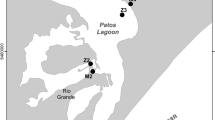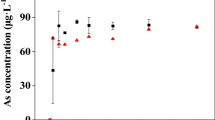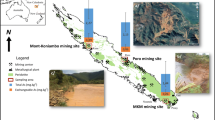Abstract
There has been increasing concern over As in freshwater environments from sources such as arsenical pesticides, smelters, coal-fired power plants, and erosion caused by intensive land use. Arsenic in the reduced state, As (III) (arsenite), is much more toxic, more soluble and mobile, than when in the oxidized state, As (V) (arsenate). This paper summarizes the dynamics and mechanisms involved in the oxidation of As (III) to As (V) by freshwater lake sediments. Sediments from selected freshwater lakes in southern Saskatchewan oxidize As (III) to As (V) predominantly through an abiotic process. Solution analysis of As (III) and As (V) by colorimetry, and examination of the oxidation state of surface-sorbed As species by X-ray photoelectron spectroscopy, indicate that Mn present in the sediment is the primary electron acceptor in the oxidation of As (III). The transformation of As (III) to As (V) by carbonate and silicate minerals, common in sediments, is not evident. The heat of activation, ΔHa, for the depletion (oxidation plus sorption) of As (III) by the sediments, varies from 3.3 to 8.5 kcal mole−1, indicating that the process is predominantly diffusion-controlled. The Mn present in a series of particle size fractions ( < 2– > 20 µm) of the sediments may potentially detoxify As (III) in aquatic systems, by converting it to As (V).
Similar content being viewed by others
References
Andreae,M. O.,1978.Distribution and speciation of arsenic in natural waters and some marine algae.Deep-Sea Res. 25:391–402.
Browning, E., 1969. Toxicity of Industrial Metals, 2nd edn. Butterworths, London. 383 pp.
Calvert, C. C., 1975. Arsenicals in animal feeds and wastes. In: Woolson, E.A. (Ed.) Arsenical Pesticides, pp. 70–80. CS Symposium Series 7. Am. Chem. Soc., Washington, D.C.
Chao, T. T., 1972. Selective dissolution of manganese oxides from soils and sediments with acidified hydroxylamine hydrochloride. Soil Sci. Soc. Am. Proc. 36: 764–768.
Demayo, A., Taylor, M. C. & Reeder, S. W., 1979. Guidelines for Surface Water Quality, Vol. 1: Inorganic Chemical Substances-Arsenic. Inland Water Directorate, Water Quality Branch, Ottawa. 13 pp.
Ferguson, J. F. & Gavis, J., 1972. A review of the arsenic cycle in natural waters. Water Res. 6: 1259–1274.
Fishbein, L., 1972. Natural non-nutrient substances in the food chain. Sci. Total Environ. 1: 211–244.
Fordham, A. W. & Norrish, K., 1979. Arsenate-73 uptake by components of several acidic soils and its implications for phosphate retention. Aust. J. Soil Res. 17: 307–316.
Förstner, U. & Wittmann, G. T. W., 1979. Metal Pollution in the Aquatic Environment, pp. 250–258. Springer Verlag, New York.
Glasstone, S., Laidler, K. J. & Eyring, H., 1941. The Theory of Rate Processes, pp. 400–401. McGraw-Hill, New York.
Gulens, J., Champ, D. R. & Jackson, R. E., 1979. Influence of redox environments on the mobility of arsenic in ground water. In: Jenne, E. A. (Ed.) Chemical Modeling in Aqueous Systems, pp. 81–95. Am. Chem. Soc., Symp. Ser. 93
Holm, T. R., Anderson, M. A., Iverson, D. G. & Stanforth, R. S., 1979. Heterogeneous interactions of arsenic in aquatic systems. In: Jenne, E. A., (Ed.) Chemical Modeling in Aqueous Systems, pp. 711–736. Chem. Soc., Symp. Ser. 93.
Huang, P. M., 1975. Retention of arsenic by hydroxy-aluminum on surfaces of micaceous mineral colloids. Soil Sci. Soc. Am. Proc. 39: 271–274.
Huang, P. M., 1980. Adsorption processes in soils. In: Hutzinger, O. (Ed.) Handbook of Environmental Chemistry, pp. 47–59. Springer Verlag, Amsterdam.
Huang, P. M. & Liaw, W. K., 1978. Distribution and fractionation of arsenic in selected freshwater lake sediments. Int. Revue ges. Hydrobiol. 63: 533–543.
Huang, P. M. & Liaw, W. K., 1979. Adsorption of arsenite by lake sediments. Int. Revue ges. Hydrobiol. 64: 263–271.
Huang, P. M., Wang, T. S. C., Wang, M. K., Wu, M. H. & Hsu, N. W., 1977. Retention of phenolic acids by noncrystalline hydroxy-aluminum and -iron compounds and clay minerals of soils. Soil Sci. 123: 213–219.
Judson, S., 1968. Erosion of the land. Am. Scient. 56: 356–374.
Latimer, W. M., 1952. Oxidation States of the Elements and their Potentials in Aqueous Solutions, 2nd ed. Prentice-Hall, Englewood Cliffs, N.J. 392 pp.
McKenzie, R. M., 1971. The synthesis of birnessite, cryptomelane, and other oxides and hydroxides of manganese. Mineral Mag. 38: 493–502.
Oscarson, D. W., Huang, P. M. & Liaw, W. K., 1980. The oxidation of arsenite by aquatic sediments. J. environ. Qual. 9: 700–703.
Oscarson, D. W., Rogers, J. S., Huang, P. M. & Liaw, W. K., 1981a. The nature of selected prairie lake and stream sediments. Int. Revue ges. Hydrobiol. 66: 95–107.
Oscarson, D. W., Huang, P. M., Defosse, C. & Herbillon, A., 1981b. Oxidative power of Mn(IV) and Fe(III) oxides with respect to As(III) in terrestrial and aquatic environments. Nature 291 (5810): 50–51.
Oscarson, D. W., Huang, P. M. & Liaw, W. K., 1981c. The role of manganese in the oxidation of arsenite by freshwater lake sediments. Clays and Clay Minerals 29: 219–225.
Oscarson, D. W., Liaw, W. K. & Huang, P. M., 1981d. The kinetics and components involved in the oxidation of arsenite by freshwater lake sediments. Verh. int. Verein. Limnol. 21: 181–186.
Parfit, R. L., 1978. Anion adsorption by soils and soil materials. Adv. Agron. 30: 1–51.
Penrose, W. R., 1974. Arsenic in the marine and aquatic environments: analysis, occurrence, and significance. CRC Crit. Rev. Environ. Cont. 4: 465–482.
Stumm, W. & Morgan, J. J., 1970. Aquatic Chemistry. Wiley-Interscience, New York. 583 pp.
Tremearne, T. H. & Jacob, K. D., 1941. Arsenic in natural phosphates and phosphate fertilizers. USDA Tech. Bull. No. 781, USDA, Washington, D. C. 40 pp.
Walsh, L. M. & Keeney, D. R., 1975. Behavior and phytotoxicity of inorganic arsenicals in soils. In: Woolson, E. A., (ed.) Arsenical Pesticides, pp. 35–52. Am. Chem. Soc., Washington, D. C.
Author information
Authors and Affiliations
Rights and permissions
About this article
Cite this article
Huang, P.M., Oscarson, D.W., Liaw, W.K. et al. Dynamics and mechanisms of arsenite oxidation by freshwater lake sediments. Hydrobiologia 91, 315–322 (1982). https://doi.org/10.1007/BF02391948
Issue Date:
DOI: https://doi.org/10.1007/BF02391948




